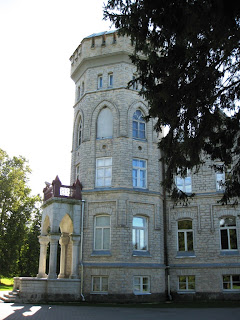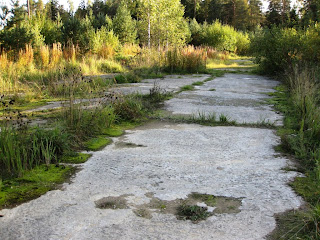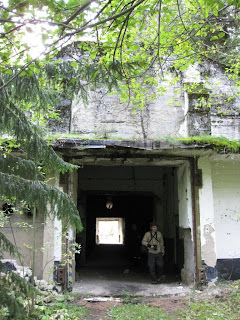
In the spring 2008 joint-group of the School of Esoteric Geography (S.E.G.) and Romantic Geographic Society (R.G.S.) explored with success the peripheric and secret places of Estonia. The spark of enthusiasm remained long after. In September 2009 co-operative expedition was launched again. Some places of intrest were re-checked, many new discovered.
Estonia rightfully boasts with her deep cultural layers and marvels of nature. The country is treasured with attractive views and conventional beauty, that is something not to deny. However, it is also a land of strong contrasts, dark shadows, largely because of its stormy history. Reminders of those dark spots are often not so pleasant to watch, at least not in a traditional sense, but in their own way they deepen and intensify the atmosphere of whole country. In the following picture journey we explore some of the hidden and shady corners of Estonia, which can be seen as a subconsciousness, in some cases even nightmares, of the land. When eyes get used to darkness there seems to be also a humourous smile of the impermanence and absurdity.
LAAGRI
The first stop outside Tallinn was a abandoned underground headqauters of the Soviet Baltic Sea Navy (Mereväebaasi komandopunkt), which is located in Laagri region in a wasteland outskirts of recent risen commercial blocks. Hidden under small grassy hill it goes down as a catacomb of three levels and forms complex labyrinth. The deserted bunker is, of course, pitch-dark, moist and brutal after all possible interior things and materials of it are either evacuated, stolen or smashed. The entrance had been closed in careless style by caterpillar and still allowed an uncanny cave tour below.
Name "Laagri" means "camp" (compare: "Lager" in German). The area has such a name, because there were a prison camp during the World War I and after that during the indepedence war.

The final look back before entering the depths of the catacomb.

Underground halls remind in some cases ancient temples with their pillars.

Some heavy machines, maybe Sixties' computers, have needed strong basements.

Underground heart chamber was found after long tunnels and many corners. It has height of three floors and has propably been something similiar than the war-room seen in the Kubrick's movie "Dr. Strangelove or: How I Learned to Stop Worrying and Love the Bomb".

It was a relief to climb outdoors. The somewhat nauseatic sense of "what if" -history followed after the visit to the military nervecenter of now lost but in its own time highly dangerous regime.

Nearby there are many bunkers from czar's era built for the World War I. Some of them had been in use also during the Soviet time.

An explorer in his duty.

Still in Laagri. The ruins of submarine command center. This building with some decorativeness has probably been for officers.

Silence fell quickly and unwarned.

Suprisingly we found out that this building was occupied by homeless couple. The woman told she has seven children. Why they have left her in these corridors?

Around the base old and new times meet. No historical preservation status is granted for Soviet military ruins when land is needed for boom building.

On the roadside we spotted ruined church, which has probably served as a barn during communistic rule.

Now the church was under labourous renovation and seemingly already in temporal use.

The church-yard trucks.

Estonia is full of bit dusty but warmly nostalgic places. Small railway stations are not an exception. This one is in Aegviidu, built at 1870.
ARUKULA

In Aruküla we bumped into army storehouse area left behind by occupying Red Army. The night was falling and we had just time to peep into couple of houses.

The storage rooms were still relatively dry.

Here are some standard Soviet glass covers for lamps of different sizes.

This place seemed to promise horror.

It was getting dark...

... when we noticed that the place housed thousands of gas masks. Plenty of children size was also available.
JÄRVA-JAANI

We do go to a school in a sensitive age. They are always intresting to see, also in state of "eternal summer holiday" like this one in Järva-Jaani some 80 kilometers south-west from Tallinn.

The hall had seen many ceremonies of joy and propaganda. Now it was hot behind big windows, captured butterflies wanted desperately out.

Which class I am supposed to attend?...

The hand of time cannot be bribed.

The neat pile of bricks shows that somebody was about to demolish the place in order. The smashed TV reveals he lost his nerves.

The biggest suprise was to discover that there was a prison cell in the basement of the school. No bullshit was tolerated from the pupils, it seems.

Teachers' house.

For comparison: this school with noble flavour was still in use (not in Järva-Jaani, though, but in Vasalemma).

In Järva-Jaani there's also an automobile freak having large and quite marvellous collection outdoors in a muddy lawn. This one is at least in practical use.

Nostalgic parade of eastern cars, once so difficult to buy and now already so rare to find.

Heavy vechiles ready to serve the empire.

Political message was not forgotten in details of cars.

The unique feeling of Soviet bus ride.

The statement for power and scientific-techical superiority of man over nature.

This bus is for green house effect, that's for sure.
ROHU AND KADILA
In the vicinity of Väike-Maarja, deep in the silent woods of idylic countryside and behind suprisingly small roads we were fated to face Soviet nuclear missile bases of Rohu and Kadila. What is now complex of mute ruins used to be place where 304. Missile Regiment once hosted R-12-type missiles, sixteen in total. They were able to carry 1 or 2,3 megatons of nuclear explosives and turn the world in incurable turmoil. The local people were lured to believe there was an artillery unit in the forest. No one could see the truth, since the area was surrounded by many guarded zones and had eletrical wire nets alarming on touch the machine gunners. The base was emptied by Soviets already 1978 when its weapons, originally introduced 1959, had become techically outdated.

The cave for mayhem rockets had to have uniform temperature (+4 C) and humidity throughout a year.

For our expedition group these were really the chambers for deep thoughts. In the same time the past seemed distant and unreal like a dream.

Inside the missile base.

Text from the wall of one missile hangar.

Some remains seemed to belong more to an ancient civilization than 20th century.

Nuclear missiles housed here had four levels of readiness: from 4) it would have taken 3h 25 min to start the attack, from 3) 2h 20 min, from 2) 1h and from "total" phase 1) 30 minutes. We don't know how often Moscow commanded the readiness number one to be set...

Outdoors basement where the missiles were supposed to be erected for launch.

Strange architecture for insane purposes.

Silent gang patrolling the leftovers of the Cold War.
VALASTE

Some fresh sea air was needed. It was kindly provided by Gulf of Finland.

Valaste brook falls down from the cliff to the shore.

Estonian limestone is completely diffrent from the Finnish bedrock and features rich vegetation.
ASERI

Aseri in the north coast shares the fate of many small Estonian towns and hamlets. After the Soviet occupation the new reality has not provided enough activities and inhabitants to keep places alive. The flower setting in the central yard of the town blossoms hope, but one third of houses of the main road are abandond and in many cases already in ruins.

The houses of Aseri stands as a school example of so called Stalinistic architecture. Although built in late 40' and early 50' they seem much older in style.

In the midst of ruins it feels there was after all a second independence war in Estonia. It just happened with neglection instead of bombs.

Some backyards of Aseri.
SILLAMÄE
After visiting Rohu and Kadila nuclear weapon bases and contemplating their mental imprint, it was a kind of schock therapy to enter an abandonded nuclear raid shelter with original educational posters about the nuclear war. This kind of place was visited in Sillamäe. The town itself was founded in the late Forties for secret nuclear projects and remained long as an offically non-existing commune, whose inhabitants were broght outside Estonia and had their official addresses in Leningrad and Moscow.

The entrance of forgotten shelter.

The flash of camera takes away the true feeling of the place. It is pitch-dark and need to be explored with torch-lamps.

Some markings of a new era were also evident in the sleeping gallery.

This poster is explaining in detail which kind of weapons and in which way are threathning the lives of the citizens of peace loving CCCP.

Part of air pump system meant to filter the lethal outdoors air after an atom bomb attack on Soviet republic.

Catastrophe activities after the attack.

More of the stuff.

In the midst of bizarre visions one may remember that the purpose of the underground exhibition was, after all, to protect. Or just to give some opium-kind of wishful thinking...

Explorer Jussi Kivi has rescued some samples of Sillamäe art in his Fire & Rescue Museum -installation, which is at this moment in display at Venice Biennale.

The mental landscape of the artist and his audience seem morbid and paranoid. On the other hand, the possibility of total destruction by nuclear weapons has not ceased; it's just out of the sight nowadays.

Stepping out for light and forever away from Sillamäe underground gallery!
VIIVIKONNA
Viivikonna in one the peripherical hamlets in Estonia located behind a dead-end road some 10 kilometers southn from Sillamäe. Outside the village opens vast and desert-like wasteland formed by the mining industry of oil shale (so called "burning stone"). Like many rugged and out-of-time places in the country, Viivikonna has number of empty and ruined buildings amongst still inhabited quaters. In Estonian language it has been called "kummituslinn", which means a "ghost townn".
The sense of impermanence and fleeting nature of phenomena must be strong amongst people down in such places. We may remember a Buddhist sutra saying: "Of all footprints, the elephant's are outstanding; just so, of all subjects of meditation for a follower of the Buddha, the idea of impermanence is unsurpassed". However, even with the attitude of wanting to investigate the true nature of phenomena, the extreme ghost town -surrounding like Viivikonna's can easily be experienced as overwhelmingly depressing.
Before Viivikonna it was anyway time to seek some fuel for our van...

Gas station spotted. Let's go there!

A meter and our faithfull rental Transit.

No-one seem to serve today...

Roadside wonder: huge industrial block left to fade away. Original purpose unknown.

This could have been a bus station of Viivikonna.

A bit of Elvis' Graceland in this mistreated palace.

Those still living in Viivikonna have their own peripherical style to live, which was seen, for example, in vechiles that could never enter the streets of the towns more tightly under central powers.

On the roads of Viivikonna.

Also newer houses have share the merciless fate.

The eye for ruin romanticism has food here.

The slowly creeping autum flavoured the atmosphere of decay.
FROM VIIVIKONNA TO KOSE

At Viivikonna there was located German WWII concentration camp and so also outside of it, at Vaivara. Victims are not forgotten.

Modern day concentration camp can easily be seen in the way we treat animals for example in broiler industry. This unit is fortunately abandonded. Still, very bad "kaarma".

Huge halls housed even hundreds of thousands of victims in each round.

Control.

At Kose near Jõhvi we stopped at administration house left behind by Red government in early 1990s'. The archive room had a half of meter thick layer of documents at its floor.

Faces and fates from the past.

What was done in dark was brought into light...
PILOT CEMETERY OF ÄMARI (Thanks for the hint, Otso Kantokorpi)
In south-west from Estonian capital there's lonely military airfield of Ämari at the end of long dead-end road. Near the partly ruined village of the location there slumbers a bit eerie forest cemetery once established for the Soviet pilots who got killed in service. Some parts of planes have been used in grave monuments as we will see in the next pictures.

The peace in the forest.

Often there were two victims in one crash.

The Facebook of dead ones.

This crash seems particularly tragic: young fellows lost their lives at the very last spring of Estonia's occupation and the existence of Soviet Union.
RUMMU
Under 50 kilometers south-west from Tallinn at Rummu village there is a tough-looking Murru prison. Next to it stands odd artificial mountain made by slag of local mining industry. The look of the hill and its surroundings would allow Estonians to shoot there a western movie in spaghetti style. Extra visual kicks are provided by the "too blue" industrial lake and old half drowned ruins next to the mountain.

Very uplifting, surreal and mesmerizing hill.

A human is small compared to human's work.

A treasure of geoglogical patterns.

Deserted mining quaters beside the hill and behind them prison walls.

A rich buckthorn berry harvest awaited to nourish an explorer of Rummu hill.
EVERY JOURNEY ENDS

Beside the railway tracks, somewhere at the industrial backlands of Tallinn was the place for the last picnic of our gang of geographers.
The expedition group: Jussi Kivi, Tero Kontinen & Marko Leppänen.